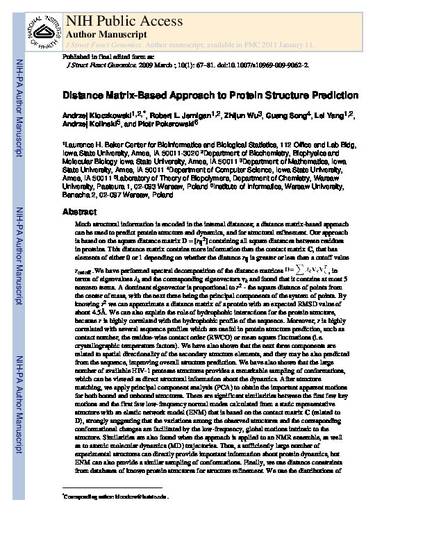
Much structural information is encoded in the internal distances; a distance matrix-based approach can be used to predict protein structure and dynamics, and for structural refinement. Our approach is based on the square distance matrix D = [rij2] containing all square distances between residues in proteins. This distance matrix contains more information than the contact matrix C, that has elements of either 0 or 1 depending on whether the distance rij is greater or less than a cutoff value rcutoff .We have performed spectral decomposition of the distance matrices D=∑λkVkVTk , in terms of eigenvalues λk and the corresponding eigenvectors vk and found that it contains at most 5 nonzero terms. A dominant eigenvector is proportional to r2 - the square distance of points from the center of mass, with the next three being the principal components of the system of points. By knowing r2 we can approximate a distance matrix of a protein with an expected RMSD value of about 4.5Å. We can also explain the role of hydrophobic interactions for the protein structure, because r is highly correlated with the hydrophobic profile of the sequence. Moreover, r is highly correlated with several sequence profiles which are useful in protein structure prediction, such as contact number, the residue-wise contact order (RWCO) or mean square fluctuations (i.e. crystallographic temperature factors). We have also shown that the next three components are related to spatial directionality of the secondary structure elements, and they may be also predicted from the sequence, improving overall structure prediction. We have also shown that the large number of available HIV-1 protease structures provides a remarkable sampling of conformations, which can be viewed as direct structural information about the dynamics. After structure matching, we apply principal component analysis (PCA) to obtain the important apparent motions for both bound and unbound structures. There are significant similarities between the first few key motions and the first few low-frequency normal modes calculated from a static representative structure with an elastic network model (ENM) that is based on the contact matrix C (related to D), strongly suggesting that the variations among the observed structures and the corresponding conformational changes are facilitated by the low-frequency, global motions intrinsic to the structure. Similarities are also found when the approach is applied to an NMR ensemble, as well as to atomic molecular dynamics (MD) trajectories. Thus, a sufficiently large number of experimental structures can directly provide important information about protein dynamics, but ENM can also provide a similar sampling of conformations. Finally, we use distance constraints from databases of known protein structures for structure refinement. We use the distributions of distances of various types in known protein structures to obtain the most probable ranges or the mean-force potentials for the distances. We then impose these constraints on structures to be refined or include the mean-force potentials directly in the energy minimization so that more plausible structural models can be built. This approach has been successfully used by us in 2006 in the CASPR structure refinement http://predictioncenter.org/caspR).
Available at: http://works.bepress.com/robert-jernigan/44/

This is a manuscript of an article published as Kloczkowski, Andrzej, Robert L. Jernigan, Zhijun Wu, Guang Song, Lei Yang, Andrzej Kolinski, and Piotr Pokarowski. "Distance matrix-based approach to protein structure prediction." Journal of structural and functional genomics 10, no. 1 (2009): 67-81. The final publication is available at Springer via http://dx.doi.org/10.1007/s10969-009-9062-2. Posted with permission.